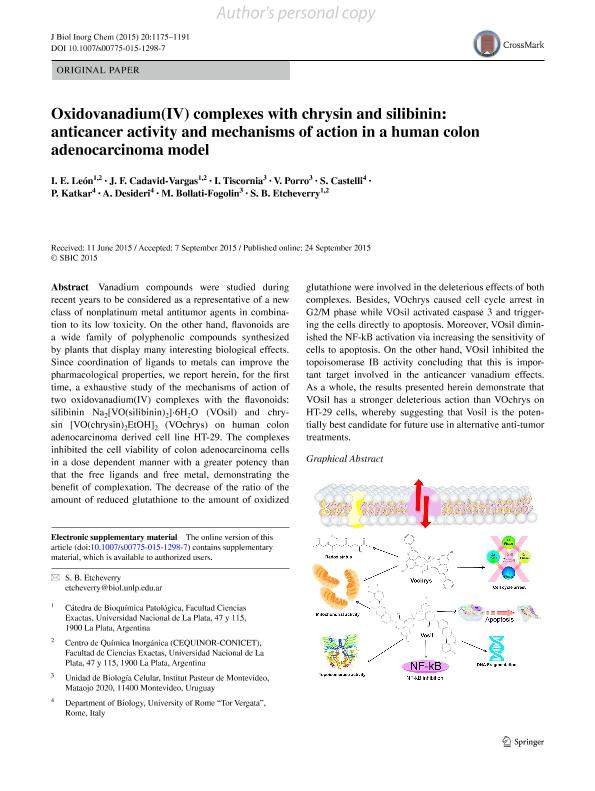Mostrar el registro sencillo del ítem
dc.contributor.author
Leon, Ignacio Esteban

dc.contributor.author
Cadavid Vargas, Juan Fernando

dc.contributor.author
Tiscornia, Ines Silvia

dc.contributor.author
Porro, V.
dc.contributor.author
Castelli, S.
dc.contributor.author
Katkar, P.
dc.contributor.author
Desideri, A.
dc.contributor.author
Bollati Fogolin, M.
dc.contributor.author
Etcheverry, Susana Beatriz

dc.date.available
2018-06-12T17:57:30Z
dc.date.issued
2015-09
dc.identifier.citation
Leon, Ignacio Esteban; Cadavid Vargas, Juan Fernando; Tiscornia, Ines Silvia; Porro, V.; Castelli, S.; et al.; Oxidovanadium(IV) complexes with chrysin and silibinin: anticancer activity and mechanisms of action in a human colon adenocarcinoma model; Springer; Journal of Biological Inorganic Chemistry; 20; 7; 9-2015; 1175-1191
dc.identifier.issn
0949-8257
dc.identifier.uri
http://hdl.handle.net/11336/48372
dc.description.abstract
Vanadium compounds were studied duringrecent years to be considered as a representative of a newclass of nonplatinum metal antitumor agents in combinationto its low toxicity. On the other hand, flavonoids area wide family of polyphenolic compounds synthesizedby plants that display many interesting biological effects.Since coordination of ligands to metals can improve thepharmacological properties, we report herein, for the firsttime, a exhaustive study of the mechanisms of action oftwo oxidovanadium(IV) complexes with the flavonoids:silibinin Na2[VO(silibinin)2]·6H2O (VOsil) and chrysin[VO(chrysin)2EtOH]2 (VOchrys) on human colonadenocarcinoma derived cell line HT-29. The complexesinhibited the cell viability of colon adenocarcinoma cellsin a dose dependent manner with a greater potency thanthat the free ligands and free metal, demonstrating thebenefit of complexation. The decrease of the ratio of theamount of reduced glutathione to the amount of oxidized glutathione were involved in the deleterious effects of bothcomplexes. Besides, VOchrys caused cell cycle arrest inG2/M phase while VOsil activated caspase 3 and triggeringthe cells directly to apoptosis. Moreover, VOsil diminishedthe NF-kB activation via increasing the sensitivity ofcells to apoptosis. On the other hand, VOsil inhibited thetopoisomerase IB activity concluding that this is importanttarget involved in the anticancer vanadium effects.As a whole, the results presented herein demonstrate thatVOsil has a stronger deleterious action than VOchrys onHT-29 cells, whereby suggesting that Vosil is the potentiallybest candidate for future use in alternative anti-tumortreatments.
dc.format
application/pdf
dc.language.iso
eng
dc.publisher
Springer

dc.rights
info:eu-repo/semantics/openAccess
dc.rights.uri
https://creativecommons.org/licenses/by-nc-sa/2.5/ar/
dc.subject
Metal Based Drug ·
dc.subject
Ht-29 Cells
dc.subject
· Flavonoids ·
dc.subject
Vanadium
dc.subject.classification
Otras Ciencias Biológicas

dc.subject.classification
Ciencias Biológicas

dc.subject.classification
CIENCIAS NATURALES Y EXACTAS

dc.title
Oxidovanadium(IV) complexes with chrysin and silibinin: anticancer activity and mechanisms of action in a human colon adenocarcinoma model
dc.type
info:eu-repo/semantics/article
dc.type
info:ar-repo/semantics/artículo
dc.type
info:eu-repo/semantics/publishedVersion
dc.date.updated
2018-06-12T13:29:37Z
dc.journal.volume
20
dc.journal.number
7
dc.journal.pagination
1175-1191
dc.journal.pais
Alemania

dc.journal.ciudad
Berlin
dc.description.fil
Fil: Leon, Ignacio Esteban. Consejo Nacional de Investigaciones Científicas y Técnicas. Centro Científico Tecnológico Conicet - La Plata. Centro de Química Inorgánica "Dr. Pedro J. Aymonino". Universidad Nacional de La Plata. Facultad de Ciencias Exactas. Centro de Química Inorgánica "Dr. Pedro J. Aymonino"; Argentina. Universidad Nacional de la Plata. Facultad de Ciencias Exactas. Departamento de Ciencias Biológicas. Cátedra Bioquímica Patologica; Argentina
dc.description.fil
Fil: Cadavid Vargas, Juan Fernando. Consejo Nacional de Investigaciones Científicas y Técnicas. Centro Científico Tecnológico Conicet - La Plata. Centro de Química Inorgánica "Dr. Pedro J. Aymonino". Universidad Nacional de La Plata. Facultad de Ciencias Exactas. Centro de Química Inorgánica "Dr. Pedro J. Aymonino"; Argentina. Universidad Nacional de la Plata. Facultad de Ciencias Exactas. Departamento de Ciencias Biológicas. Cátedra Bioquímica Patologica; Argentina
dc.description.fil
Fil: Tiscornia, Ines Silvia. Instituto Pasteur de Montevideo; Uruguay
dc.description.fil
Fil: Porro, V.. Instituto Pasteur de Montevideo; Uruguay
dc.description.fil
Fil: Castelli, S.. Universita Tor Vergata; Italia
dc.description.fil
Fil: Katkar, P.. Universita Tor Vergata; Italia
dc.description.fil
Fil: Desideri, A.. Universita Tor Vergata; Italia
dc.description.fil
Fil: Bollati Fogolin, M.. Instituto Pasteur de Montevideo; Uruguay
dc.description.fil
Fil: Etcheverry, Susana Beatriz. Consejo Nacional de Investigaciones Científicas y Técnicas. Centro Científico Tecnológico Conicet - La Plata. Centro de Química Inorgánica "Dr. Pedro J. Aymonino". Universidad Nacional de La Plata. Facultad de Ciencias Exactas. Centro de Química Inorgánica "Dr. Pedro J. Aymonino"; Argentina. Universidad Nacional de la Plata. Facultad de Ciencias Exactas. Departamento de Ciencias Biológicas. Cátedra Bioquímica Patologica; Argentina
dc.journal.title
Journal of Biological Inorganic Chemistry

dc.relation.alternativeid
info:eu-repo/semantics/altIdentifier/doi/https://dx.doi.org/10.1007/s00775-015-1298-7
dc.relation.alternativeid
info:eu-repo/semantics/altIdentifier/url/https://link.springer.com/article/10.1007%2Fs00775-015-1298-7
Archivos asociados
